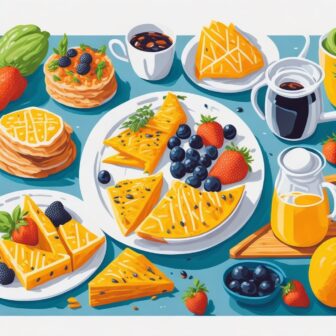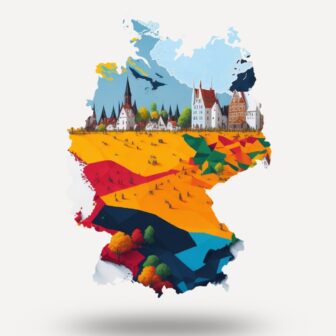62 Insanely Delicious Traditional German Desserts You’ll Want to Try
Looking to try some traditional German desserts during your trip in Germany? Most German desserts can be found at the backers, in markets and shops. If you like sweet treats that are great for your soul, then this list of German desserts is for you! These classic German desserts are perfect anytime. Enjoy!
Black Forest Cake - Schwarzwälder Kirschtorte
The Black Forest cake is a festive addition to your holiday meal.
Also known as Black Forest Gateau, this traditional German dessert consists of two or more layers of chocolate sponge cake topped with whipped cream and cherries.
In some versions, the layers of chocolate are drenched in decadent cherry syrup or cherry brandy. The whipped cream is sometimes lightly flavored.
I recommend adding extra cool whip before serving.
Pancakes with apple sauce - Pfannkuchen mit Apfelmus
The secret to good German style pancakes with apple sauce is the fact that Apfelmus is done with regional apples. Every year I am looking forward to the apple varieties that are really good for applesauce, such as Boskoop, Cox Orange or Berlepsch.
Peppernuts - Pfeffernüsse
You can never have enough Pfeffernüsse!
Pfeffernüsse are small spice cookies popular during the holiday season in Germany and among ethnic Mennonites in the United States.
Anise seeds or anise extract give peppernuts their unique liquorice taste. The addition of ground black pepper and their round shape inspired the name “Peppernuts”.
Gingerbread Men - Lebkuchenmänner
Gingerbread men literally translates to “gingerbread men” in English. Gingerbread cookies and gingerbread houses have their origins in Germany in the 16th century. These cookies are also associated with the Christmas tradition in the United States.
Gingerbread House - Lebkuchenhaus
Lebkuchenhaus literally means “gingerbread house” in English. You can eat gingerbread houses! The decorations are also edible unless you add non-food items. Gingerbread houses are a real crowd puller!
Bremen Klaben
Bremer Klaben, often called Klaben, is a German Stollen (fruit bread) that originated in Bremen. Stollen is a fruit bread covered with powdered sugar or glaze. This well-known treat is popular in Northern Germany during the Christmas season when it is called Christstollen or Christmas Stollen.
Bavarian cream - Bayrische Sahne
Bavarian cream is a cream that has been bound with gelatin and enriched with whipped cream. Bavarian cream can be flavored with chocolate, coffee, fruit, and other ingredients. It is usually shaped into a fancy shape and topped with fruit or a sweet sauce.
Cheesecake - Käsekuchen
German cheesecake looks a lot like American cheesecake. But the use of slightly tart cottage cheese makes it a lighter dessert with both sweet and tangy flavors. Traditional German-style cheesecake, often topped with various fruits and a thin layer of dough.
Baked apple - Bratapfel
Baked apples are very popular in Germany throughout the winter season, especially around Christmas. The apples are baked with fillings such as marzipan, hazelnut cream, almonds and/or raisins. The aroma of cloves and cinnamon is very festive. This dish can be accompanied with ice cream or vanilla sauce.
Apple Pie - Apfelkuchen
This traditional German apple pie is a simple vanilla cake with thinly sliced fresh apples on top. If you slice the apples without cutting them all the way through, you’ll get a nice fan effect when baking. The cake looks so pretty and chic when dusted with fresh powdered sugar.
Depending on the region of Germany, the cake is often coated in cinnamon sugar, topped with flaky sprinkles, or drenched in custard. Sliced apple pie is usually served in the afternoon as a filling dessert with coffee or tea.
Bethman - Bethmännchen
Bethmännchen are spherical marzipan pastries made from almonds, flour, rose water, powdered sugar and egg. It is one of the most popular and popular German holiday treats. These biscuits were originally baked as a tribute to the Bethmann family from Frankfurt am Main.
Buchtel
Buchtel is a sweet, pull-apart bun made from enriched yeast dough and cooked in a large skillet. Traditionally, buchtel is filled with plum jam. Buchtel can be eaten pure or sprinkled with powdered sugar. Buchtel (the plural form of buchtel) can also be topped with vanilla sauce and eaten warm.
Bee Sting - Bienenstich
German bee stitch cake is a two-layer cake that is usually baked in a rectangular pan, like a sheet cake. It consists of two layers of sweet yeast bread filled with custard and topped with a crunchy almond and honey topping. The taste ranges from nutty to sweet to yeasty, with notes of vanilla and honey. This cake has been popular for hundreds of years because it has different tastes and textures (soft, creamy and crunchy).
Apple strudel - Apfelstrudel
The dessert is a long strip of strudel pastry filled with apples. The filling is made with grated cooking apples (usually Winesap apples), sugar, cinnamon, and breadcrumbs. The dough for strudel is unleavened.
Steamed Dumpling - Dampfnudel
Dampfnudel is a type of white bread or sweet roll. Dampfnudel contains egg and yeast and is cooked in a slightly creamy sauce. The bread is soft and sweet with a light brown crust. Dampfnudel can be savory or sweet depending on the region in Germany. Dampfnudel can be eaten as a meal or as a dessert with vanilla caramel sauce.
Linz Eye - Linzer Auge
Linzer Cookies are buttery, jam-filled sandwich cookies modeled after the traditional Viennese Linzer Torte, a nut-filled, jam-topped pastry with a lattice pattern. The finely ground almonds and almond extract in the batter give the biscuit a shortbread-like texture and nutty flavor. The biscuit is usually filled with raspberry or apricot jam and dusted with powdered sugar.
Apricot dumplings - Marillenknödel
Apricot dumplings are popular in southern Germany. Apricot dumplings are apricot dumplings that are rolled in toasted breadcrumbs and then dusted with powdered sugar. Apricot dumplings are typical of Czech and Austrian cuisine. Marillen means apricots in Austro-Bavarian.
RELATED
Best Traditional German Foods You Must Eat In Germany
Popular German Breakfast Foods To Brighten Up Your Morning
Christmas Foods in Germany: What to eat and drink in Germany
Poppy Snail - Mohnschnecke
Many bakeries sell these traditional German sweet breads. They are filled with poppy seeds and can be decorated with them. Since a lot of sugar and butter are used in the preparation, it tastes very sweet and greasy. Icing is commonly topped on this snail-like pastry.
Berliner
A Berliner is a German donut without a hole. It is made from sweet yeast dough deep fried in fat or oil. The Berliner is filled with a jam or jam, similar to a donut. It is usually topped with powdered sugar, powdered sugar, or regular sugar.
Domino - Dominostein
Dominostein is a sweet confection eaten in Germany and Austria, especially around Christmas time. The dessert is covered with a thin, dark chocolate icing and consists of several layers. The floor is made of gingerbread. Its layers are made of jelly and marzipan (or persipan). The domino was invented in Dresden in 1936.
RELATED:
Best Hotels in Dresden
Best Places to Visit in Dresden
Spaghetti Ice Cream - Spaghettieis
A Spaghettieis is a dessert that looks like a plate of spaghetti but tastes like a sundae. You wouldn’t think Germans would make spaghetti a dessert, but they’re popular in ice cream parlors across the country.
Franz rolls - Franzbrötchen
Franzbrötchen is a breakfast specialty popular in Northern Germany’s cafés and train stations. The Franzbrötchen in Hamburg is similar to a French croissant.
The sweet pastry is ideal for a quick breakfast or an afternoon snack. It goes perfectly with coffee.
Frankfurt wreath - Frankfurter Kranz
The Frankfurter Kranz is a ring-shaped sponge cake filled with thick German buttercream and topped with red jam. The outside of the cake is covered in buttercream and sprinkled with brittle, usually made from almonds and/or hazelnuts.
Carnival - Fasnacht
Fasnacht is a fried donut usually eaten during Mardi Gras, Shrove Tuesday, or on Shrove Tuesday, the day before Lent begins. They arose to consume pork, sugar, fat and lard before Lent. A real Fastnacht is served with powdered or granulated sugar on top. Unlike a donut, it has no icing, filling, or sprinkles. The potato dough used in a Shrovetide makes dense and not as sweet as a donut.
Almond croissants - Mandelhörnchen
Almond croissants are a naturally gluten-free sweet delicacy made from marzipan, almond flour and sugar, then wrapped in slivered almonds and dipped in chocolate on both ends. The almonds and chocolate enhance its flavor and texture. These horseshoe-shaped pastries are common in bakeries across Germany.
The marzipan on the inside of these horseshoe-shaped pastries goes well with the chocolate and almond slivers on the outside.
Stollen
Stollen is a Christmas dessert similar to fruitcake but without the rum soak. It’s also a little less thick, more like bread. Powdered sugar is usually sprinkled on top.
Sliced Stollen can be eaten with butter, honey or jam. Individual slices can be toasted before eating or heated in the microwave.
The word stollo means “support or post” in old German.
Bundt cake - Gugelhupf
Gugelhupf is a typical southern German dessert specialty. It’s a kind of sponge cake with the shape of a mountain on top. It is made in a unique shape.
It is a semi-sweet cake made with yeast dough, raisins, lemon and nuts, baked in a fluted tube pan.
In northern Germany and in the south of the English peninsula, Gugelhupf is known as Bundkuchen.
Cold Dog - Kalter Hund
Kalter Hund is an easy to make (no-bake) German cake made up of layers of butter biscuits that taste like vanilla and are very crunchy. This cake is smooth and crunchy at the same time.
Kalter Hund means “cold dog”. It consists of butter cookies and chocolate cream. So this is basically the opposite of a “hot dog”.
Food of the Gods - Götterspeise
Götterspeise is a dessert made from gelatin or other gelling agent, which means “food of the gods” in German, is a dessert made from gelatin. Sugar, flavorings, and food coloring are typically added. It’s similar to jelly and other gelatin desserts.
Men’s cream - Herrencreme
Herrencreme is a traditional dessert in Germany. This dessert is a custard combined with a significant amount of rum, chocolate chips, and cream. Traditionally, Herrencreme is a dessert served after a particularly large meal. This alcoholic German delicacy has both stunning looks and delicious taste.
Hot Chocolate - Heiße Schokolade
Heiße Schokolade is made from real chocolate, not to be confused with Trinkschokolade, which is made from chocolate powder. Hot chocolate wasn’t invented by the Germans. The Mayans deserve this honor. On a chilly winter’s day, drinking Germany’s hot chocolate with whipped cream is a real treat.
Waffles
Waffles are a sweet, pancake-like treat enjoyed as dessert and at coffee time. Waffles actually come from Belgium, a neighboring country of Germany. In summer it is usually served with ice cream and other fruits, but in winter it is usually eaten with custard and cherries or with spices at Christmas markets.
Ginger Snaps - Ingwerschoten
Ingwerschoten are a tasty and flavorful treat. Ingwerschoten was most likely first made by medieval monks in Franconia, Germany. Ingwerschoten bakers can be traced back to 1296 in Ulm and 1395 in Nuremberg.
German rumble cake - Streuselkuchen
Classic Streuselkuchen originated most likely in Germany, as flat cakes topped with a sweet streusel topping. Streusel cake is made with yeast dough covered in Streusel, a sweet, crumbly topping. The crumble topping consists of flour, sugar and butter.
Poppy seed cake - Mohnkuchen mit Eierdecke
This German classic has a dense poppy seed filling on a fluffy and moist cake base topped with butter crumble. Mohnkuchen is a tender cake with a crunchy base, a rich and fluffy filling, and a golden sprinkles topping. Try blackberry poppy seed cake with white chocolate ganache. It is delicious!
Raspberry Pie - Himbeertorte
Raspberries take center stage in this stunning cake. The bottom layer resembles a sugar cookie. Followed by a thin layer of sponge cake. There’s a generous layer of raspberries that are flavorful and delicious. Even if you’re not a fan of the gelatin used to keep the fruit from falling apart, you’ll love the intense raspberry flavor.
German Streusel - Deutscher Streusel
Streusel is best characterized as a crumb topping. It is usually added to muffins, bread, pies and cakes. Streusel is made from flour, butter and sugar. Streusel means “scattered or scattered” in English.
Cinnamon Stars - Zimtsterne
Cinnamon stars are star-shaped biscuits with a white icing reminiscent of snow. Every year, many households in Germany get into the Christmas spirit with these delicious dessert treats.
Cinnamon is an important part of the traditional recipe. In its purest form, cinnamon stars aren’t particularly sweet; however, it has notes of nuttiness and citrus brilliance.
German Chocolate Cake - Schokoladenkuchen
German Chocolate Cake is a layered chocolate cake with a filling and topping of coconut pecan frosting. It is a tiered chocolate cake, often with two to three layers. The filling is a thick, gooey-sweet cream that’s topped with coconut flakes and chopped walnuts. German Chocolate Cake isn’t exactly a German dessert, so the name is a bit misleading. Samuel German invented the dessert cake in the 1850s.
Red fruit jelly - Rote Grütze
One of the most common desserts in Germany is red fruit compote. In the classic recipe, raspberries and currants are used. Strawberries, blackberries or murtillas can also be added. Most often this dessert is served with ice cream, whipped cream or custard.
Rote Grütze is a dish popular in both northern Germany and Scandinavia. “Grütze” comes from the High German word “gruzzi” meaning “a ground paste with a lumpy texture” and “rote” meaning “red”.
Plum Pie - Zwetschgenkuchen
This well-known German plum cake has its origins in Swabia, in southern Germany. It features a delicious buttery crumble topping and a yeasty crust. When it is plum season in Germany, the German plum cake is a popular dessert. German plum cake is incredible, especially when topped with a dollop of freshly whipped cream. The plums become tender and sweet after baking, the cake base and the buttery crumble topping form a wonderful contrast to the sweetness.
Cottage cheese balls - Quarkabällchen
Quarkballs or quark balls are a traditional German snack made from quark, flour, eggs, sugar, vanilla sugar, and baking powder. The mixture can also include milk, melted butter, cinnamon, lemon zest, and corn or potato starch. The quark mass is formed into small balls and fried until golden brown. Then they are usually dusted with powdered or granulated sugar or a cinnamon-sugar mixture. They are often made for Christmas, New Year’s Eve, Carnival and the Oktoberfest.
Danube waves - Donauwelle
Donauwelle is a German cake made by layering two different colored cake batters, then topping with sour cherries and baking the whole thing. The cake is topped with a layer of buttercream and melted chocolate after baking.
At Donauwelle, sour cherries are sprinkled on the uncooked dough. This allows the two colors to combine and create wavy patterns inside the cake. Donauwelle is a deep rising, rich cake that can be dense depending on ingredients and baking technique. Several recipes call for yogurt to lighten the batter or keep it moist.
Plum Dumplings - Zwetschgenknödel
A classic German pastry for fall, Zwetschgenknödel make a fun dessert or main course for a weekday. The plum acidity complements the curd cheese dumplings and the cinnamon-sugar wonderfully.
All Saints’ Day - Allerheiligen
Strietzel or Allerheiligenstriezel is a yeast braid. In English it is known as “All Saints’ Braid”.
It contains flour, eggs, yeast, shortening or butter, raisins, milk, salt and decorating sugar or poppy seeds.
Rum and lemon juice are also used in some regional variations.
Alexander cake - Alexandertorte
Alexandertorte is an East German cake of Latvian origin. Traditionally eaten as a dessert for lunch or dinner, it consists of strips of dough filled with raspberry jam or raspberry jam.
The cake should be prepared a few days before serving so that the glaze hardens.
The Alexander cake is a dessert made to commemorate a visit by Tsar Alexander III. was created in Latvia.
Gingerbread - Lebkuchen
Gingerbread cookies are honey-sweetened treats that have become a Christmas tradition. Gingerbread, sometimes also called gingerbread, is a bit reminiscent of gingerbread. It’s rich, velvety, tangy, sweet, and extremely filling with a cake-like texture. Typically, it is prepared during the winter holidays. The “leb” in “lebkuchen” is derived from either the term “Leibspeis” or the German word “leben”, both of which mean “life”.
Baumkuchen
Baumkuchen is made by brushing layers of dough on a rotating skewer over an open flame. In Germany Baumkuchen is an important aspect of the Christmas holiday season.
The characteristic rings that appear when the cake is cut resemble tree rings and give the cake its name, which literally means “tree cake” or “wooden cake”. This classic German skewer cake has also gained great popularity in Japan.
Aachener Printen
Aachener Printen is a cake-shaped biscuit or bar typically sweetened with honey. Aachener Printen resembles gingerbread and is characterized by a chewy exterior and a robust, caramel-like taste. The name “Printen” alludes to the use of carved wooden forms. Aachener Printe is typically sweetened with syrup made from sugar beets instead of honey.
Prince Regent Cake - Prinzregententorte
The Prinzregententorte is a Bavarian cake. It consists of at least six, often seven, thin layers of sponge cake topped with chocolate buttercream. The cake is topped with finely chopped almonds and chocolate icing.
German Rumtopf
Rumtopf, also known as Romkrukke in Danish, literally means “rum pot”. It is an Austrian, German and Danish dessert made from mixed fruit and schnapps, often consumed around Christmas. Rumtopf is made by soaking fruit in rum and sugar for months. The most commonly used fruits are plums, strawberries and cherries.
Snowball - Schneeball
Snowball is a dessert made from shortcrust pastry. Schneeball literally means “snowball” in English. Although there are bakeries in other Bavarian towns that love snowballs, they are best known in Rothenburg ob der Tauber.
Chocolate Kiss - Schokokuss
Schokokuss is a wafer that is covered with chocolate after being spread with sugar cream. Schokokuss is always served at birthday parties, carnival and summer festivals. These treats are known in English as chocolate mousse kisses.
Speculaas - Spekulatius
Spekulatius are Christmas cookies from Germany that contain a variety of spices. These butter cookies contain speculaas spices like cardamom, cloves and cinnamon. Typically, they are prepared and enjoyed on St. Nicholas Day. This biscuit has a rich history dating back to the 15th century.
Springerle
Süddeutsche Springerle is a type of anise-flavored biscuit or cookie. They are made from a simple dough containing eggs, flour and sugar. Springerles often have a picture or pattern on them and are square or spherical in shape. The raised patterns were created using carved wooden molds or rolling pins. Giving them away at Christmas is a tradition that goes back at least 700 years.
Shortbread - Spritzgeback
Shortbread cookies are shortbread-like shortbread biscuits that are formed with a piping bag or cookie press. The main ingredients are flour, butter, sugar and eggs. Spritzgeback gets its name from the German verb “spritzen,” meaning “to squirt,” because the soft, buttery batter of this dessert is squirted through a nozzle.
German crumble cake - Streuselkuchen
Streuselkuchen (a.k.a. “crumb cake”) is a light and moist yeast-based cake topped with sweet buttery crumbs. Streusel is an easy recipe that calls for equal portions of crumbs, chilled butter, granulated sugar, and all-purpose flour. It commonly has a jam layer with fruit fillings such as apples, tart cherries, rhubarb, and gooseberries.
Clumsy - Tollatsch
Germany brought forth the Pomeranian dessert Tollatsch. The Dis is made with a combination of gingerbread spices, breadcrumbs, almonds and sugar. Tollatsch is also made from unusual ingredients like pig’s blood and lard.
Vanilla Crescents - Vanillekipferl
Vanilla crescents are butter biscuits that are made with lots of butter and often without eggs. They are a traditional Christmas cookie baked with crushed nuts and coated in vanilla. Vanilla Kipferl means “vanilla sickle” or “vanilla moon” in German, which goes well with the dessert thanks to its sickle shape. This dessert can also be made with apricots, but has traditionally been made with walnuts. These cookies melt in your mouth.
Guelph Food - Welfenspeise
Welfenspeise is a two-layer pudding that got its name from a German noble family. The colors of the Guelphs are yellow and white. The bottom white layer is made from boiled milk and custard on a base of stiffly whipped egg whites. Once cool, it’s topped with a yellow sauce made from beaten egg yolks, white wine, and lemon juice.
Wibele
Wibele are delicious biscuits that come from Langenburg in Franconia. They are a Swabian dessert. The cookies are baked and made with flour, sugar, egg whites, vanilla sugar and vanilla flavoring. Wibeles are similar to a shoe because they are shaped like an 8.
Cream puffs - Windbeutel
Windbeutel are German cream puffs made from choux pastry. They can be filled with just whipped cream, but you can also use whipped cream or ice cream. The traditional recipe for cream puffs is easy to make and one of the most spectacular quick desserts.






